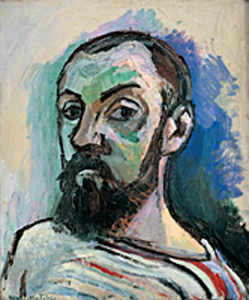1.12.24 — Beasts of Burden
“Manet / Degas,” this past year’s blockbuster at The Met, shows two great artists learning from and struggling against each other. Even more, it shows their course from the Louvre to modern life.
What would it take to go the rest of the way, from Post-Impressionism to modern art? Could it have taken two more artists working side by side? “Vertigo of Color,” in the museum’s Lehman wing, follows Henri Matisse and André Derain to a fishing village in France for a single summer. It marked a powerful convergence, celebrated or derided as Fauvism, but just as interesting is what it leaves out, through January 21—and I work this in with my recent report on “Manet / Degas” as a longer review and my latest upload. 
Just who were the Fauvists, or wild beasts? That fishing village, Collioure in 1905, looks remarkably serene. Sailboats lie still at their berths, their masts dipping like bridges across white, untroubled waters. Fishermen go quietly about their work, leaving deep blue traces on the shore. One can see why Henri Matisse called his most ambitious painting back then Luxe, Calme et Volupté (after Charles Baudelaire), with an equal emphasis on all three terms. His wife, Amélie, sits in a blue and white kimono beside the water, as if the drama of life had come to a perfect rest.
Or were the beasts the artists themselves, and was the wildness their art or the light? “The nights are radiant,” Derain wrote, “the days potent, ferocious, and victorious. The light bears down on all sides with its immense shout of victory.” The show’s title puts Matisse first, because he will always come first, but the show itself opens with facing walls for André Derain. Daubs of red, yellow, and orange daylight cover the ground and a wild green enters the sky, like Pointillism for an artist too amazed to connect the dots. Yet he seeks stability as well, in the horizontals of the horizon, the shoreline, and the meeting between trees and earth. He finds it, too, in the detachment of a high point of view.
Yet things quickly intensify, as each artist paints the other. The shadow beneath Derain’s chin divides his face between flesh and pale green, while the shadow beneath the other man’s eye could have scarred him for life. Matisse himself is consistently the wilder beast, with color for its own sake in a deeper space with a logic all its own. Their titles alone draw a contrast—between Derain’s care for the everyday labor of sailing and fishing, and Matisse’s for landscape, mountains, and the joy of life. He has an instinct for generalization from this very moment. It may come as a surprise, in the show’s third section, to discover that he painted Amélie outdoors on the spot, but he did.
The show wraps up with an extended postscript, for still life and portraits. A young sailor by Matisse could not conceivably get back to work without tempting those around him with his colors and curves. The section also takes the artists, if only briefly, into 1906. Derain brought what he had discovered to the sobriety of London at dusk. Both exhibited in the fall of 1905 in Paris. The Salon d’Automne set that year aside for Fauvism.
Yet that, too, leaves something out: the Salon counted Maurice de Vlaminck and others as Fauvists, too, in what had become not a summer’s impulse but a movement. It leaves out as well Matisse’s major works, such as Luxe, Calme et Volupté and the still greater color clashes of Woman in a Hat. Both exhibited at the Salon, but one would never know it here. The Joy of Life was soon to follow, as was the most startling of all, the portrait called (with good reason) Green Stripe. So was his ultimate breakthrough, starting in 1909 with Red Studio, and so was a very different meeting of the minds, rivalry with Picasso.
The curators, Dita Amory with Ann Dumas of the Museum of Fine Arts in Houston, leave all that out for a reason: they seek a point of origin in a pairing and a place. Matisse, they note, had been to Collioure before and would come again. Derain may have loved the night, but he never returned. Origins, though, have a way of receding into myth. This is beautiful art, but it stops short of the origins of Fauvism—or of modern art.
Read more, now in a feature-length article on this site.